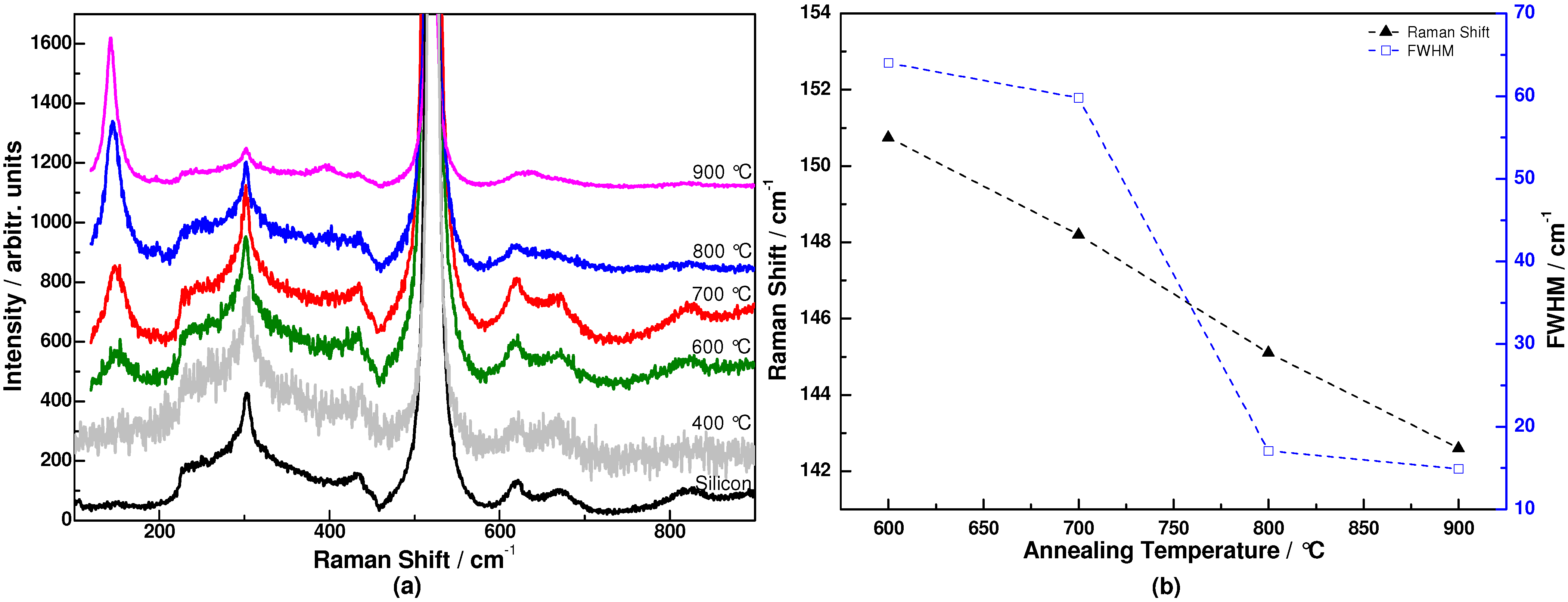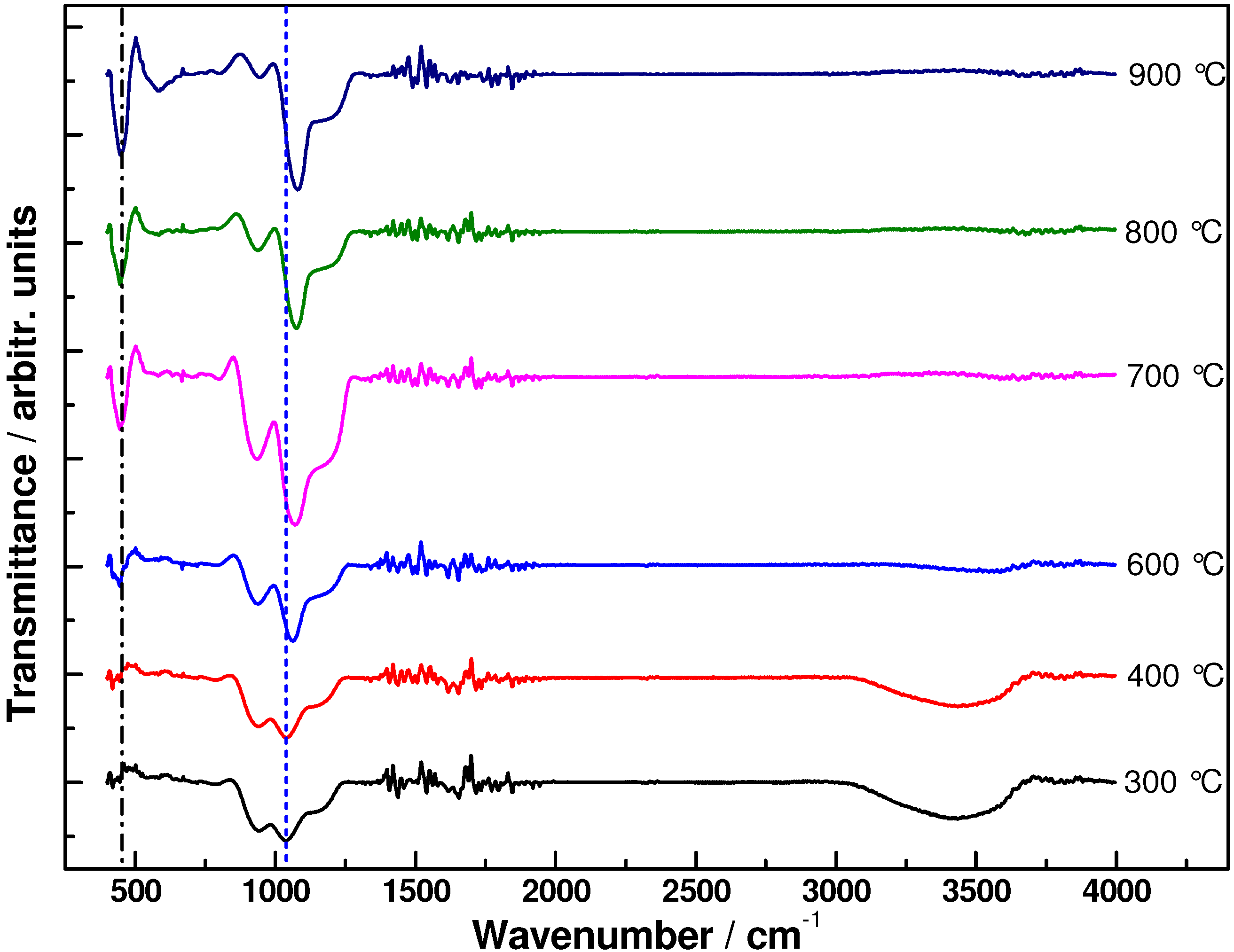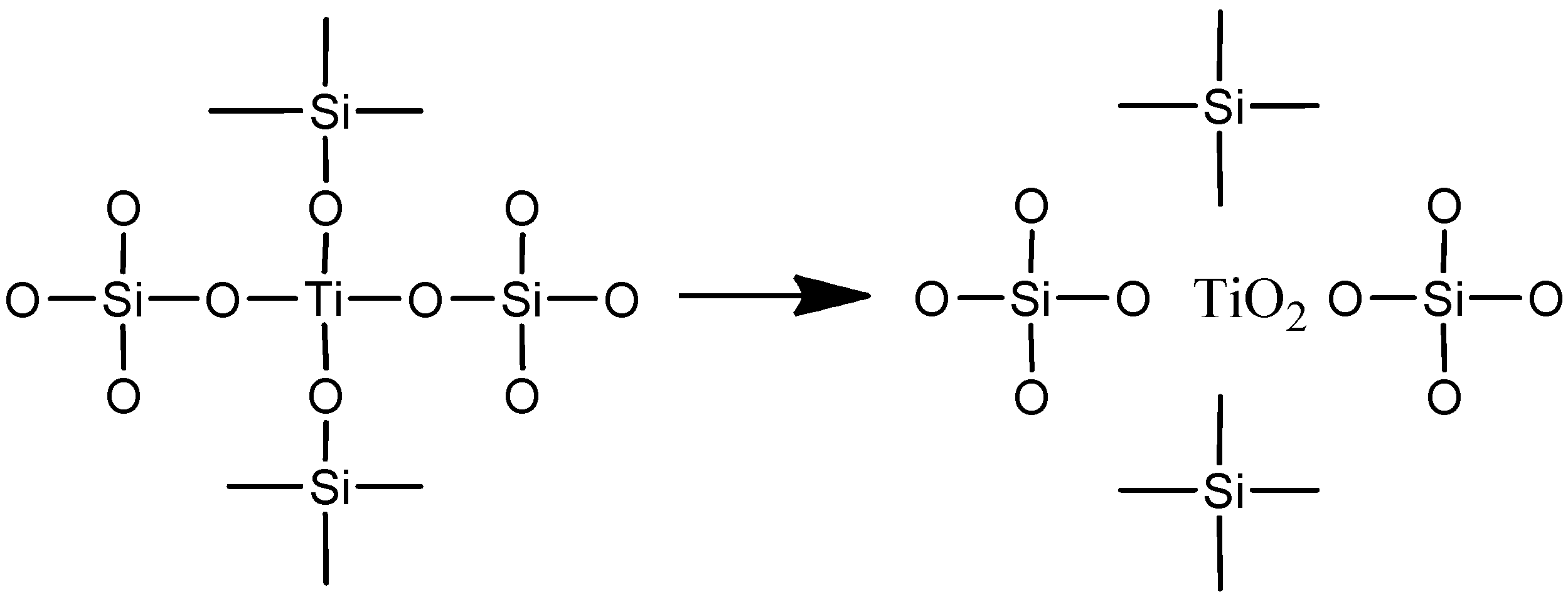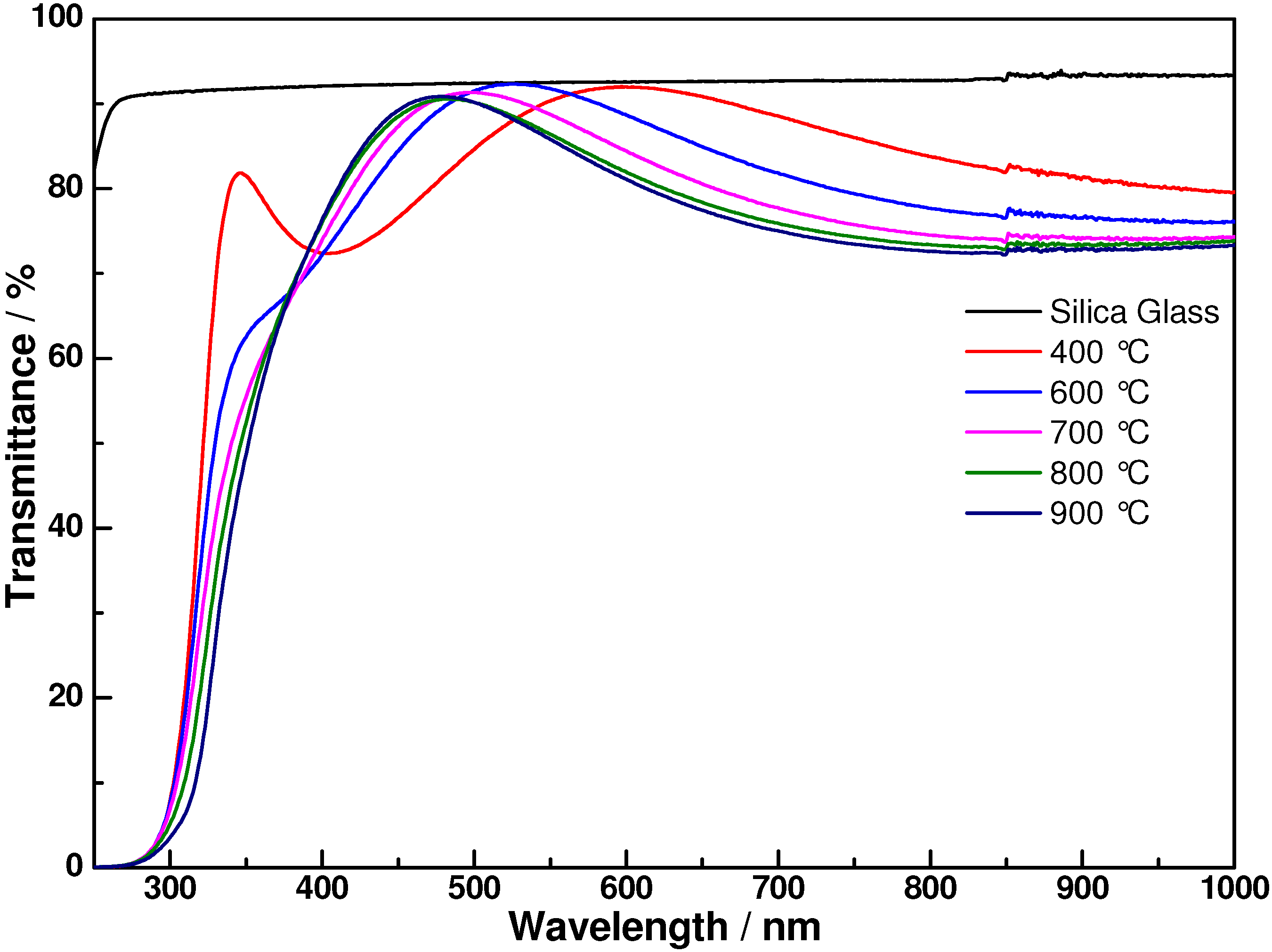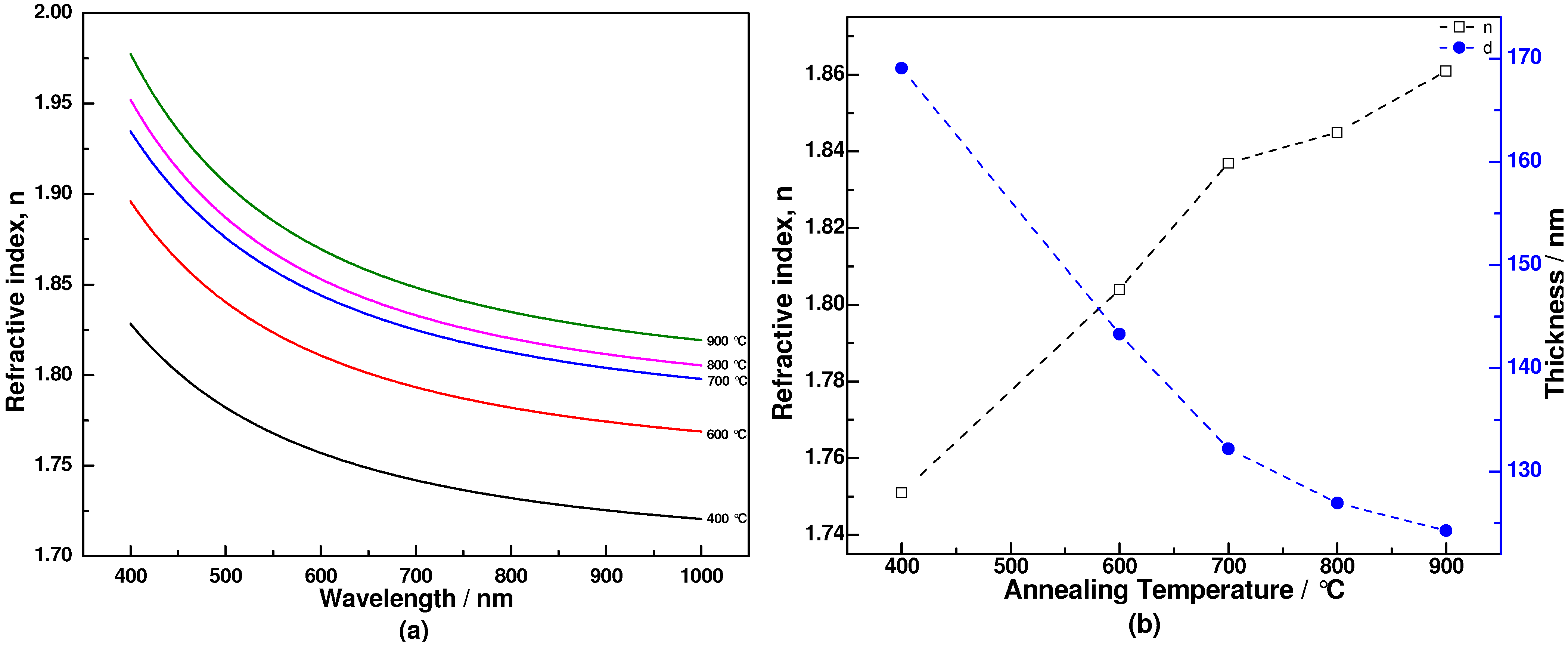1. Introduction
In optical thin film application, it is important to have tunable refractive indices over a range as large as possible and continuously if feasible. Due to the low cost, wide spectral region of transparency from visible to near infrared [
1], as well as the high chemical and thermal stabilities, SiO
2 and TiO
2 are commonly used as low and high refractive index materials, respectively. So far, they have been successfully used in optical device applications, such as antireflective coatings [
2], high reflecting mirrors [
3], beam splitter [
4] and planar waveguides [
5]. Binary TiO
2-SiO
2 coatings cover a wide range of achievable refractive index [
6,
7] from approximately 1.45 to 2.55 because of the large difference in refractive index of the two compounds. A large number of deposition techniques including electron beam evaporation [
8], sputtering [
9], pulsed laser deposition [
10], sol-gel [
11,
12,
13] and chemical vapor deposition [
14] have been used to prepare the binary TiO
2-SiO
2 coatings. However, most reports deal with these types of thin films on an empirical basis, without correlating the actual values of the optical parameters with the type of thin film microstructure and the composition. The detailed influence of microstructure or that of a partial or total segregation of the pure oxides is still not available. A recent exception in this regard is the work of Louis
et al. [
12], which constitutes a thorough investigation of the correlations between the microstructure of SiO
2/TiO
2 thin films and their optical properties. They investigated how the binary coating is affected by the mixing ratio of the two oxides and the thermal annealing of the samples through an
in situ thermal ellipsometry analysis. They showed that the silica proportion was critical to the crystallization of TiO
2 as well as to the optical properties. However, as the binary coating is synthesized by a chemical sol-gel method, the detailed annealing influence on composition and microstructure with respect to their optical properties has neither been of concern nor has it been studied. It is of interest to study the thermal annealing effect on the change of optical properties of the binary coatings.
In this work, we report on the synthesis and characterization of binary TiO2-SiO2 optical coatings prepared by a sol-gel method. The synthesized coatings were normally thermally annealed to achieve certain optical and mechanical properties. The crystal structures and composition of the coatings annealed at various temperatures were investigated by Raman and FTIR spectroscopy, respectively. The refractive indices of the coatings were extracted from reflectance and transmittance spectra. The comprehensive analysis of the thermal annealing effect on the optical properties of binary TiO2-SiO2 coatings was then discussed. We demonstrated that the increase in refractive index was due to the combined effects of the removal of the organic component, phase separation and the crystal structure transition of the binary coatings.
3. Results and Discussion
Figure 1a shows the evolution of the Raman spectra of binary TiO
2-SiO
2 coatings after thermal annealing at different temperatures. The spectra of coatings annealed below 600 °C do not differ from that of the Si substrate, which is in agreement with an amorphous state and also with the fact that crystallization is more difficult in the presence of SiO
2 [
12]. Indeed several authors [
15,
16] previously reported that silicon atoms, if intimately mixed with titanium atoms, act as barriers to the diffusion of the Ti atoms which tends to delay nucleation-growth of TiO
2 crystallites. After annealing at 600 °C, a small and broad band was detected around 151 cm
−1. This band can be assigned to the low wavenumber anatase E
g mode [
17], which indicates the beginning of TiO
2 crystallization. With increasing annealing temperatures, the E
g line becomes better defined and shifts towards smaller wavenumbers. After annealing at 900 °C, the spectrum shows a well-defined E
g line at ~143 cm
−1, as well as two other characteristic lines [
18] (197, 394 cm
−1) of the TiO
2 anatase phase. However, no rutile phase related Raman mode was detected. The presence of silica seems to not only delay the crystallization into anatase but also the transformation into rutile, which is likely due to the contribution of surface free energy associated with smaller crystallites, as recently shown by Smitha et al [
15]. Absence of phase transition also tends to prove that TiO
2 and SiO
2 are homogeneously mixed at the molecular level.
The peak position and full width at half maximum (FWHM) of the E
g band during annealing are shown in
Figure 1b. As can be seen from the figure, the peak position of anatase TiO
2 E
g mode shifts from 151 to 143 cm
−1 whereas the FWHM decreases from 64 to 14.9 cm
−1 consecutively. The possible origins of the peak shift and sharpening are due to size-induced phonon confinement [
19], non-stoichiometry and stress effect. The decrease in the crystallite dimension to the nanometer scale can cause wavenumber shift and broadening of the Raman bands as a result of phonon confinement. During annealing, the increase of annealing temperature improves the crystalline quality of TiO
2 and also causes an increase of the TiO
2 grain size. The increasing crystal size reduces the phonon confinement effect, whereas the improved crystalline quality decreases the FWHM. In addition, the phase separation of TiO
2 and SiO
2 relaxes the compressive stress effect of the SiO
2 matrix on the TiO
2 nano-grains, resulting in the E
g mode shifts toward lower wavenumbers. Therefore, all these effects need to be taken into consideration to explain the change of the E
g Raman mode.
Figure 1.
(a) Raman spectra of coatings annealed at different temperatures; (b) Peak position and full width at half maximum (FWHM) of Eg Raman peak.
Figure 1.
(a) Raman spectra of coatings annealed at different temperatures; (b) Peak position and full width at half maximum (FWHM) of Eg Raman peak.
To further understand more about the structural variation of the binary coatings during thermal annealing, the FTIR spectra of TiO
2-SiO
2 binary coatings annealed at different temperatures were performed and are shown in
Figure 2. The strongest absorption peak approximately 1060 cm
−1 is assigned to the asymmetric vibration of Si–O–Si bonds [
20]. The absorption band approximately 900~1000 cm
−1 is attributed to the stretching vibrations of Si–OH, SiO
− groups and Si–O–Ti bonds. The broad band approximately 3200~3600 cm
−1 is attributed to the OH stretching vibration of different Si–OH species and to molecular water as well, and the band at 1616 cm
−1 is attributed to adsorbed water. Both the bands decrease in intensity with increasing annealing temperature, showing that the hydroxyl groups are removed gradually from the coatings. Upon annealing at 600 °C, the intensity of the absorption band corresponding to Si–O–Si increases whereas the band approximately 900~1000 cm
−1 decreases, which indicates the phase separation of crystalline TiO
2 from the amorphous TiO
2-SiO
2 matrix.
The phase separation process can be expressed as shown in
Figure 3. With further increasing annealing temperatures, the band of anatase TiO
2 (~445 cm
−1) becomes more significant due to more complete crystallization of the TiO
2 phase. In addition, the band approximately 1060 cm
−1 can be clearly observed to shift towards higher wavenumber with increasing temperature, from approximately 1037 cm
−1 after annealing at 300 °C to 1078 cm
−1 after annealing at 900 °C. This position variation could be related to the elimination of oxygen deficiency [
21]. After higher temperature treatment, TiO
2-SiO
2 phase separation together with TiO
2 crystallization decrease the oxygen deficiency of SiO
2, thereby resulting in a blue shift of the Si–O–Si vibration peak.
Figure 2.
Fourier Transform Infrared spectra of coatings annealed at different temperatures.
Figure 2.
Fourier Transform Infrared spectra of coatings annealed at different temperatures.
Figure 3.
Schematic diagram of TiO2-SiO2 phase separation.
Figure 3.
Schematic diagram of TiO2-SiO2 phase separation.
Transmittance spectra of the coatings annealed at various temperatures in the wavelength region of 250 to 1000 nm are presented in
Figure 4. Silica glasses were used as the substrate in these experiments to avoid the influence of the absorption edge of the substrate. As shown in
Figure 4, the average transmittance of 400 °C annealed films is about 80% in the visible region with respect to silica glass substrate. It also can be seen clearly that the films are fully transparent in the visible region and start absorbing between 320 and 340 nm. Film annealed at 400 °C has the lowest absorption edge because the amorphous film has a large band gap. With increasing annealing temperature, it shows a gradual decrease in transmittance and the absorption edge shifts toward longer wavelength, indicating a decrease in the band gap of the films. This can be attributed to the structure change and the crystallization of the TiO
2 content of the binary coatings.
Figure 4.
Transmittance spectra of SiO2-TiO2 coatings annealed at different temperatures.
Figure 4.
Transmittance spectra of SiO2-TiO2 coatings annealed at different temperatures.
The optical constants, e.g., refractive index, thickness, are a topic of fundamental and technological importance in optical coatings. In order to see the annealing effect on the optical properties of the coatings, the refractive indices were determined by the characterization technique based on least-square fitting to the measured reflectance and transmittance spectra [
22]. For sol-gel dip-coating technology, both sides of the glass substrates were coated. Therefore, we built a five-layer (Air/coating layer/Silica glass/coating layer/Air) model to determine the optical constants of the film by the spectroscopic method. The Cauchy formula [
23], which is an optical model for insulators and dielectric films, was used to describe the dispersion relationship of the film layer. The optical parameters of the coating layer were then determined from the measured transmittance and reflectance spectra for each coating by fitting simultaneously the results obtained from calculations and measurements over the 400~1000 nm region.
The determined refractive indices, as a function of wavelength for binary coatings annealed at different temperatures, are shown in
Figure 5. Decreasing refractive index with wavelength indicates normal dispersion behavior. The data show that the refractive index increases with annealing temperature, from 1.75 to 1.86 at He-Ne laser wavelength of 633 nm. It is known that removal of the residual organic material and densification of the coating occurs during the thermal annealing process. Combined with the FTIR and Raman analysis, we know that the 400 °C annealed coating still has residual organic materials, and that the coating is composed of Ti–O–Si, amorphous SiO
2 and TiO
2, therefore resulting in a relatively low refractive index. After annealing at 600 °C, the removed organic groups, phase separation and the formed anatase TiO
2 rapidly increase the refractive index of the binary coating. Further increase of the annealing temperature promotes the extent of crystallization and the thermal densification of the coating, thus increasing the refractive index slightly. Therefore, the increase of refractive index is due to complex changes in the organic component removal and changes caused by the film component, phase separation and crystal structure of the binary coatings. On the other hand, on removal of organic components and thermal densification, the binary coating thickness decreases continuously from 169 to 124 nm during the annealing process.
Figure 5.
(a) Refractive index dispersion of binary coatings annealed at various temperatures; (b) Variation of refractive index (at 633 nm) and thickness of coatings annealed at various temperatures.
Figure 5.
(a) Refractive index dispersion of binary coatings annealed at various temperatures; (b) Variation of refractive index (at 633 nm) and thickness of coatings annealed at various temperatures.
